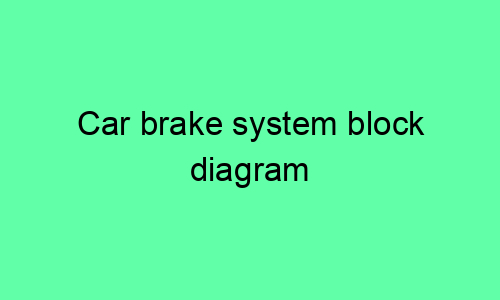Car Brake System Block Diagram
Introduction
A car brake system is a vital safety feature that helps to slow down or stop the vehicle. It consists of several components that work together to create friction between the brake pads and the brake rotors, which converts kinetic energy into heat and slows down the vehicle. The brake system is typically controlled by the driver through the brake pedal, which is connected to the master cylinder. The master cylinder then pressurizes the brake fluid, which is sent through the brake lines to the brake calipers. The brake calipers then use the brake fluid pressure to push the brake pads against the brake rotors, creating friction and slowing down the vehicle.
Block Diagram
The following block diagram shows the main components of a car brake system:
[Image of a car brake system block diagram]
The main components of the brake system are:
* **Brake pedal:** The brake pedal is used by the driver to control the brake system. When the driver presses on the brake pedal, it activates the master cylinder.
* **Master cylinder:** The master cylinder is a hydraulic device that converts the force applied to the brake pedal into hydraulic pressure. This pressure is then sent through the brake lines to the brake calipers.
* **Brake lines:** The brake lines are a series of tubes that carry the brake fluid from the master cylinder to the brake calipers.
* **Brake calipers:** The brake calipers are hydraulic devices that use the brake fluid pressure to push the brake pads against the brake rotors.
* **Brake pads:** The brake pads are friction material that is pressed against the brake rotors to create friction and slow down the vehicle.
* **Brake rotors:** The brake rotors are metal discs that are attached to the wheels. They provide a surface for the brake pads to rub against.
How the Brake System Works
When the driver presses on the brake pedal, the brake pedal activates the master cylinder. The master cylinder then converts the force applied to the brake pedal into hydraulic pressure. This pressure is then sent through the brake lines to the brake calipers. The brake calipers then use the brake fluid pressure to push the brake pads against the brake rotors, creating friction and slowing down the vehicle.
The amount of braking force is determined by the amount of pressure applied to the brake pedal. The harder the driver presses on the brake pedal, the more pressure is sent to the brake calipers and the more braking force is applied.
Brake System Safety
The brake system is a critical safety feature. It is important to keep the brake system in good working order to ensure that the vehicle can be stopped safely. Some tips for keeping the brake system in good working order include:
* Regularly check the brake fluid level.
* Have the brake pads and rotors inspected regularly.
* Have the brake system flushed and bled every few years.
* If you experience any problems with the brake system, such as a spongy brake pedal or a loss of braking power, have the system inspected by a qualified mechanic immediately.
Conclusion
The car brake system is a vital safety feature that helps to slow down or stop the vehicle. It consists of several components that work together to create friction between the brake pads and the brake rotors, which converts kinetic energy into heat and slows down the vehicle. The brake system is typically controlled by the driver through the brake pedal, which is connected to the master cylinder. The master cylinder then pressurizes the brake fluid, which is sent through the brake lines to the brake calipers. The brake calipers then use the brake fluid pressure to push the brake pads against the brake rotors, creating friction and slowing down the vehicle.






